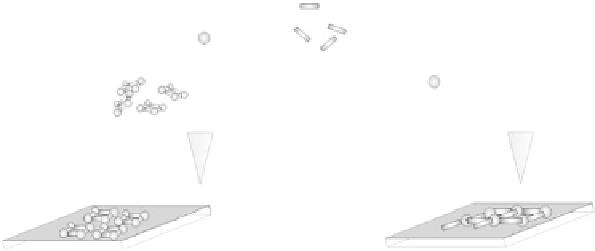Information Technology Reference
In-Depth Information
coherence, i.e., the ability to protect the molecular information from deteriora-
tion. Among the multitude of evoked quantum computing schemes and algo-
rithms, the implementation of Grover''s algorithm in high-spin molecules
exhibiting a slow relaxation of magnetism seems to be a realistic option [12].
12.1.5. Surface-Confined Self-Assembly
There are main two ways to apply supramolecular self-assembly and self-
organization techniques in order to steer molecules on surfaces (Fig. 12.3A,B):
A(i), the molecules can be pre-assembled from their components (organic
compounds, metal ions, anions, etc.) under bulk conditions. A(ii) Subsequently,
the so formed supramolecules will be deposited on the surfaces in a second,
separated step. (B) In a one-step-procedure, the same molecular components can
be deposited altogether onto the respective surface by a surface-assisted self-
assembly protocol. There, reversible, weak intermolecular forces (hydrogen
bonding, metal coordination, van der Waals forces, etc.) will lead, if the molecular
components are sufficiently instructed, to highly ordered surface-confined self-
assembled network structures (right in Fig. 12.3). Both concepts will be discussed
separately in the following two sections, whereby only highly ordered, matrix-like
assemblies will be presented due to their general interests in computing concepts.
It is beyond the scope of this chapter to review the more general field of surface-
deposition of molecules [13]. In both approaches, straightforward scanning
Organic
molecules
Surface-assisted
self-assembly
(i) Bulk-based
self-assembly
+
Metal ions
STM
STM
(ii) Surface
deposition
A
B
Figure
12.3.
Schematic representation of the two general concepts steering the
surface-confined organization of molecules and metal ions on surfaces: (A)The
two-tiered approach involving (i) bulk self-assembly and (ii) surface deposition.
(B) The one-step procedure of surface-assisted self-assembly by depositing
organic ligands (rods) and metal ions directly on surfaces. In both approaches,
scanning tunneling microscopy (STM) provides direct access to the nanodimen-
sion of the supramolecular self-organization processes.















Search WWH ::

Custom Search